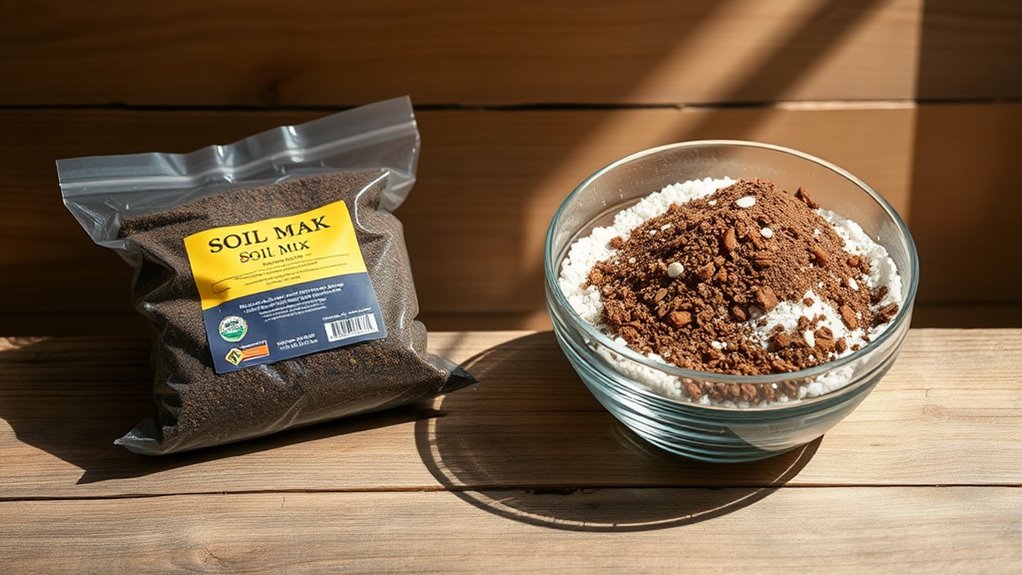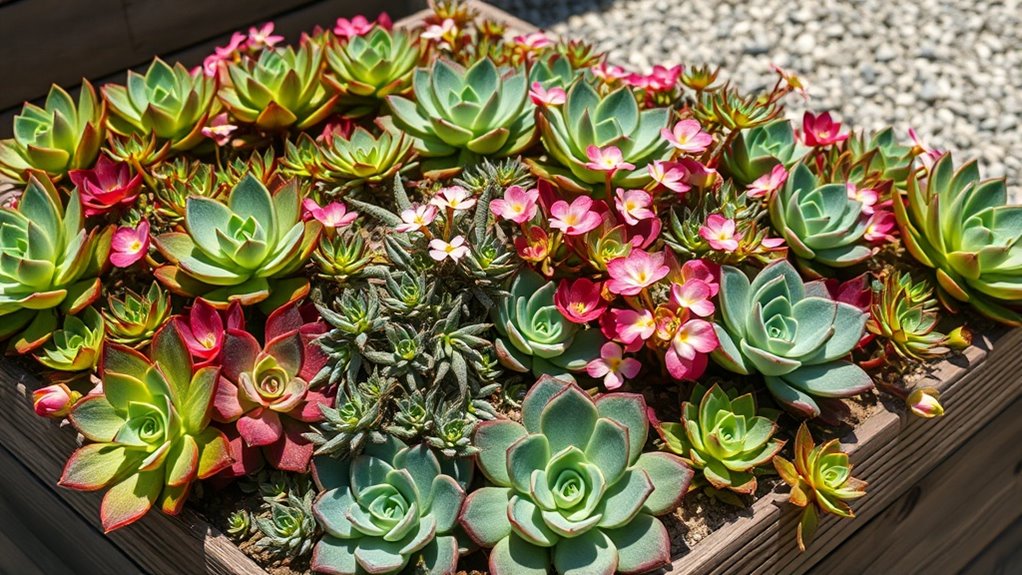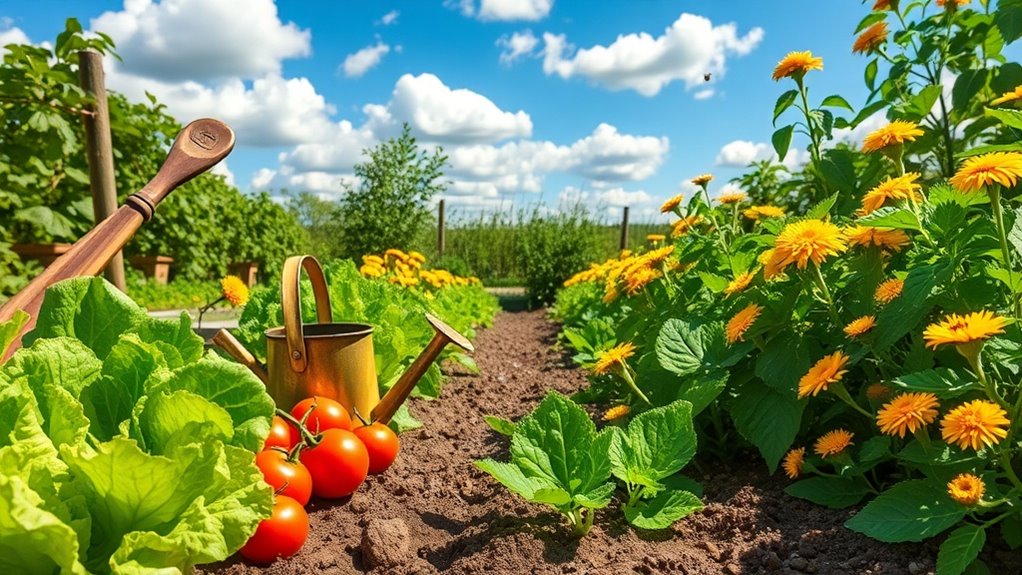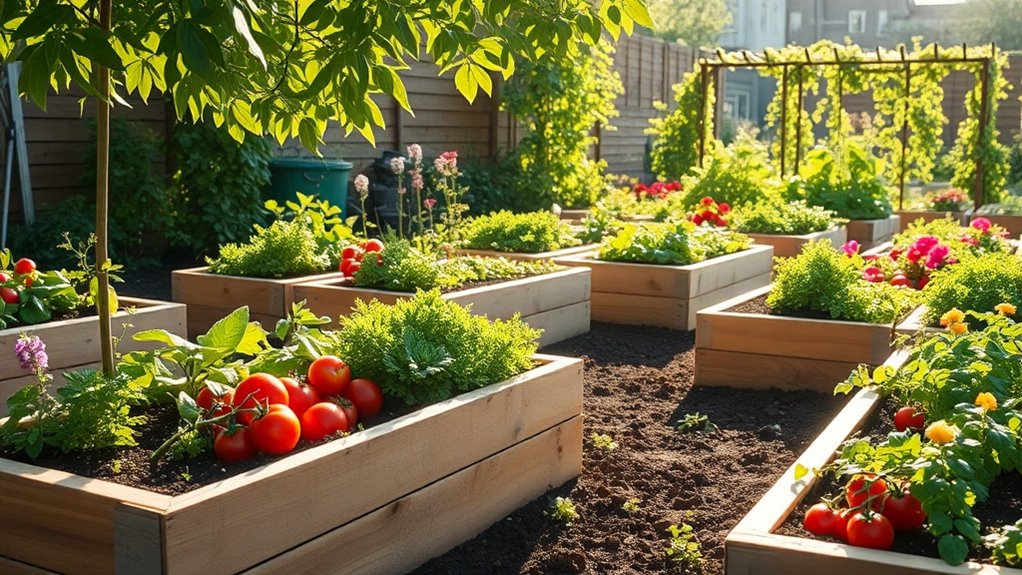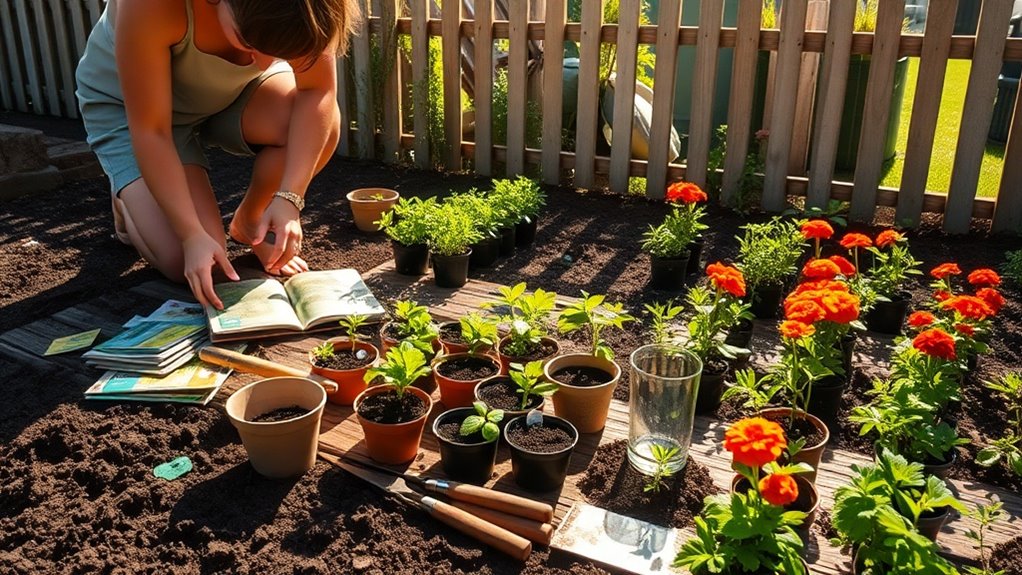The Truth About Store-Bought Soil Mixes (And What I Use Instead)
Store-bought soil mixes might seem convenient, but they’re often riddled with drawbacks like poor drainage that suffocates roots, nutrient imbalances causing yellow leaves or stunted growth, and hidden additives like synthetic fertilizers that disrupt pH and introduce contaminants. That’s why you’re better off crafting a custom blend using peat moss for moisture, perlite for aeration, and compost for nutrients—tailored to your plants’ needs for healthier results. Explore these options further to optimize your garden’s success.
Key Takeaways
- Store-bought soil mixes often suffer from poor drainage and nutrient imbalances, leading to stunted plant growth and root issues.
- Hidden ingredients like synthetic fertilizers or contaminants in commercial blends can disrupt soil pH and introduce health risks.
- Custom soil mixes allow for precise tailoring to plant needs, using components like peat moss, perlite, and compost for optimal results.
- Test custom blends for pH (aim for 6.0-7.0), drainage, and nutrients to ensure they support healthy root development.
- DIY soil mixes reduce costs, minimize contaminants, and improve plant health by providing better aeration and nutrient delivery.
Drawbacks of Store-Bought Soil Mixes
While store-bought soil mixes offer quick convenience, you’ll often encounter drawbacks that affect your plants’ health.
Commercially prepared soils may not suit your plants’ specific needs, like adequate aeration or tailored nutrient release, leading to compacted roots and poor water management. This inconsistency can stunt growth and invite pests.
Instead, explore soil alternatives such as homemade blends with perlite, vermiculite, and compost, which you can adjust for better texture and microbial balance. Moreover, these alternatives can be enhanced with natural techniques derived from everyday backyard materials to promote sustainable soil improvement.
By opting for these alternatives, you can achieve better results for your gardening needs.
Common Quality Issues in Commercial Soils
When you buy commercial soils, you’ll often notice poor drainage that causes water to pool and harm your plants’ roots.
This issue stems from improper soil composition, leading to root rot and stunted growth.
Nutrient imbalances in these mixes can also disrupt your plants’ health, as excess or deficient elements affect vital processes like photosynthesis. To effectively resolve these nutrient problems, gardeners should consider soil testing as a key step for accurate diagnosis.
By recognizing soil signs, gardeners can better assess and address underlying soil health issues for optimal plant growth.
Poor Drainage
Poor drainage often tops the list of quality issues in commercial soil mixes, causing water to accumulate and suffocate plant roots. You see this when excess moisture displaces air, depriving roots of oxygen and fostering fungal diseases like root rot.
Scientifically, compacted or clay-heavy soils hinder water percolation, leading to anaerobic conditions that stress plants. Practically, test your mix by observing if water pools on the surface or if roots feel mushy.
Choose products labeled with coarse materials like perlite to enhance flow, keeping your garden thriving without constant issues.
Nutrient Imbalances
Nutrient imbalances in commercial soil mixes often undermine plant health, delivering either excess or deficient nutrients that disrupt growth. You might notice stunted development or leaf discoloration because these mixes don’t tailor nutrients to your plants’ needs. To spot issues, check for specific symptoms.
| Nutrient | Effects of Imbalance |
|---|---|
| Nitrogen | Excess: Leaf burn; Deficiency: Yellowing |
| Phosphorus | Excess: Root damage; Deficiency: Poor flowering |
| Potassium | Excess: Nutrient lockout; Deficiency: Weak stems |
| Calcium | Excess: pH imbalance; Deficiency: Blossom end rot |
| Magnesium | Excess: Toxicity; Deficiency: Interveinal chlorosis |
Address this by testing your soil and amending it yourself for optimal results.
Hidden Ingredients in Pre-Packaged Blends
Have you ever wondered what undisclosed additives lurk in pre-packaged soil blends?
Manufacturers often slip in synthetic fertilizers, pesticides, and wetting agents to boost moisture retention or prevent pests, but these aren’t always transparent.
Scientifically, such ingredients can include trace heavy metals or chemical stabilizers that alter soil pH and microbial balance unexpectedly.
Practically, you might find inert fillers like perlite or vermiculite, which seem harmless but could harbor contaminants.
Always scrutinize labels for vague terms, and test blends for pH and nutrient levels before use to ensure they’re suitable for your plants. Moreover, performing soil testing before planting can enhance plant health and prevent costly mistakes by revealing hidden issues in these mixes.
To make informed choices, it’s crucial to debunk soil myths that could mislead gardeners about the true composition of these mixes.
Why I Avoid Store-Bought Options
While many gardeners rely on store-bought soil mixes for convenience, I’ve chosen to avoid them due to potential risks that compromise plant health and soil integrity.
You might encounter hidden contaminants like heavy metals or pesticides, which disrupt root systems and nutrient absorption. Inconsistent sterilization can introduce pathogens, such as harmful fungi or bacteria, leading to diseases that weaken your plants.
Scientifically, these mixes often have unstable pH or poor drainage, fostering root rot and reducing microbial diversity. Practically, this unreliability forces you to monitor soil quality constantly, risking poor yields and wasted effort. For instance, by making simple ingredient swaps in your compost, you can enhance the decomposition process for richer soil.
Instead, I prefer organic composting to create a sustainable and nutrient-rich soil alternative using kitchen scraps and garden waste.
My Go-To Soil Alternatives
Instead of relying on store-bought mixes, I opt for reliable alternatives like homemade compost and natural amendments.
You’ll find homemade compost enriches your soil with essential nutrients, fostering beneficial microbes that enhance plant growth and disease resistance. It’s cost-effective and reduces waste, as you recycle kitchen scraps into a nutrient-dense mix. This simple composting technique can turn your kitchen scraps into valuable garden gold.
Natural amendments, such as worm castings or leaf mold, improve soil structure, boost water retention, and promote aeration without synthetic chemicals.
By choosing these, you’re creating a sustainable, scientifically backed environment that supports healthier roots and yields.
Experiment cautiously for optimal results.
To enhance my gardening efforts, I follow an easy composting routine each week to produce nutrient-rich black gold soil for my garden.
How to Create a Custom Soil Mix
You can create your own custom soil mix by selecting ingredients that suit your plants’ specific needs, such as peat, perlite, or compost.
Then, combine these components in precise ratios to achieve the ideal texture and nutrient balance.
After mixing, test the blend for pH levels and water retention to confirm it’s optimal for growth.
Furthermore, incorporating universal methods from soil preparation techniques ensures your mix adapts effectively to various environmental conditions.
Choose Ingredients
Creating a custom soil mix starts with carefully selecting ingredients that meet your plants’ specific needs. You assess key factors like pH balance, water retention, and aeration requirements based on your plants’ types and growth stages.
Draw from scientific principles, such as particle size distribution for optimal drainage and nutrient availability. Prioritize high-quality, sustainable sources to avoid contaminants or inconsistencies.
This targeted approach ensures your mix promotes healthy root systems and efficient growth, tailoring it precisely to avoid the limitations of commercial options. By focusing on these criteria, you’re setting up for success.
Mix Components
Once you’ve selected your ingredients, blend them in precise ratios to craft a custom soil mix that optimizes pH, drainage, and nutrient delivery for your plants.
To achieve this, start with a base of peat moss for moisture retention and acidity control. Add perlite or vermiculite for improved aeration and drainage, typically at 30-50% of the mix. Include compost or worm castings for nutrients, aiming for 10-20%.
For specific plants, adjust with sand for better drainage or lime to raise pH. Use a large mixing bowl or tarp to combine ingredients thoroughly, ensuring even blending. Always wear gloves and work in a well-ventilated area to avoid dust.
Measure components by volume for accuracy, using buckets or cups. This balanced approach tailors the mix to your plants’ needs.
Test Mixture
Testing a custom soil mix guarantees it meets your plants’ needs before use.
You’ll gather components like peat moss, perlite, and compost based on your plants’ preferences—e.g., more perlite for cacti to enhance drainage.
Start with a small batch: mix one part each in a container.
Scientifically test pH with a soil kit, aiming for 6.0-7.0; assess moisture by watering and timing drainage.
Measure nutrient levels using a simple tester.
If results fall short, adjust ratios and retest.
This practical method ensures optimal growth, avoiding store-bought pitfalls through precise, evidence-based tweaks.
Benefits of DIY Soil Blends
While store-bought soil mixes offer convenience, you’ll find that creating your own DIY blends gives you greater control and customization to meet your plants’ specific needs, allowing you to optimize for factors like drainage and nutrient levels based on scientific principles.
-
Tailor nutrient profiles****: You can mix components like compost and perlite to match exact pH and mineral requirements, promoting healthier root growth.
-
Reduce costs: Sourcing materials locally cuts expenses, making it economical for large-scale gardening.
-
Minimize contaminants: Avoid synthetic additives by using organic ingredients, ensuring purer soil for sensitive plants.
-
Improve texture and aeration****: Adjust particle sizes for better water retention and oxygen flow, enhancing overall plant resilience.
Additionally, by incorporating natural soil preparation methods, you can significantly boost your harvest without relying on fertilizers, resulting in healthier plants and a higher yield.
Tips for Optimizing Your Soil Choices
When you select soil for your garden, focus on key factors like pH balance and drainage to ensure your plants thrive.
First, test your soil’s pH with a reliable kit; most plants prefer 6.0 to 7.0, so adjust with lime if acidic or sulfur if alkaline.
Improve drainage by adding perlite or coarse sand to avoid waterlogging, which can cause root rot. Incorporate organic matter like compost to enhance nutrients and microbial activity, promoting healthier growth.
Consider your plants’ specific needs—cacti require well-drained mixes, while leafy greens thrive in moisture-retaining soils.
Regularly monitor and amend for optimal results, steering clear of generic store-bought options that may lack customization.

